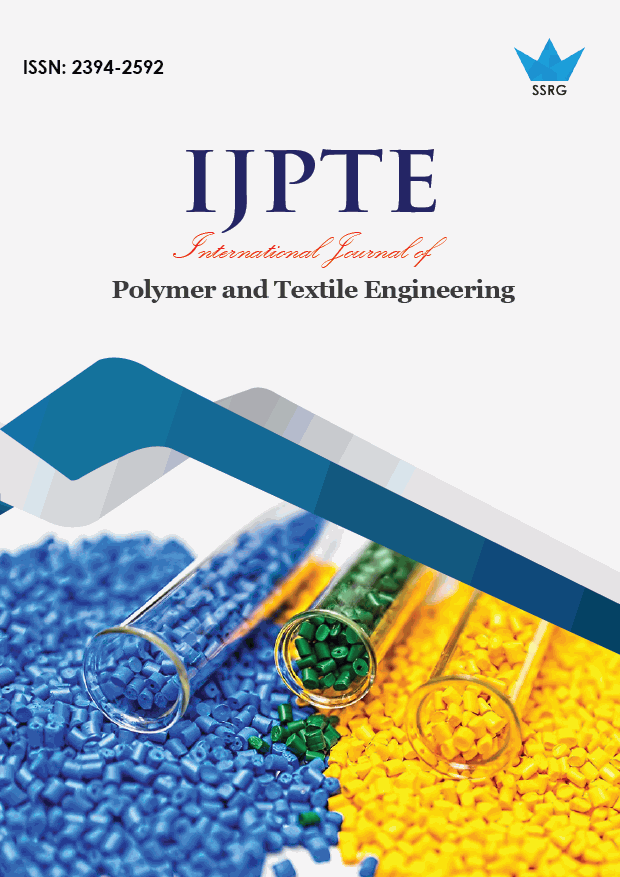Reactive Dyeing of Viscose Fabric using Polyacrylamide for Absorption

| International Journal of Polymer and Textile Engineering |
| © 2023 by SSRG - IJPTE Journal |
| Volume 10 Issue 3 |
| Year of Publication : 2023 |
| Authors : Syed Atiqur Rahman |
How to Cite?
Syed Atiqur Rahman, "Reactive Dyeing of Viscose Fabric using Polyacrylamide for Absorption," SSRG International Journal of Polymer and Textile Engineering, vol. 10, no. 3, pp. 1-5, 2023. Crossref, https://doi.org/10.14445/23942592/IJPTE-V10I3P101
Abstract:
This article describes a method for dyeing the viscose fabric with a reactive dye using polyacrylamide to absorb 0.5, 1, 2, 3, and 4% shades. Similar viscose fabrics were dyed with the identical reactive dye to the like shades (%), deploying Glauber’s salt as absorbent. The difference between the samples of like shades (%) unveiled that the samples colored with polyacrylamide are comparatively lighter. The tests of wash fastness of both types of samples furnish similar results with good fastness, and the tests of rubbing fastness of both types of samples purvey similar results with medium to good fastnesses.
Keywords:
Viscose fabric, Reactive color, Polyacrylamide, Spectrophotometry, Wash fastness.
References:
[1] 7 Things you need to Know about Viscose, ISPO.com, 2023. [Online]. Available: https://www.ispo.com/en/trends/7-things-you-need-know-about-viscose
[2] M.A. Rahman Bhuiyan, Abu Shaid, and M.A. Khan, “Cationization of Cotton Fiber by Chitosan and Its Dyeing with Reactive Dye without Salt,” Chemical and Materials Engineering, vol. 2, no. 4, pp. 96-100, 2014.
[CrossRef] [Google Scholar] [Publisher Link]
[3] M.A. Wei, Zhang Shu-fen, and Yang Jin-zong, “Development of Functional Polymers in Modification of Cotton for Improving Dyeability of Reactive Dyes,” The Proceedings of the 3rd International Conference on Functional Molecules, pp. 1-7, 2002.
[Google Scholar] [Publisher Link]
[4] Impacts of Salinity, Environment, Land and Water, Queensland Government, 2013. [Online]. Available: https://www.qld.gov.au/environment/land/management/soil/salinity/impacts
[5] S.M. Burkinshaw et al., “The Use of Dendrimers to Modify the Dyeing Behavior of Reactive Dyes on Cotton,” Dyes and Pigments, vol. 47, no. 3, pp. 259-267, 2000.
[CrossRef] [Google Scholar] [Publisher Link]
[6] Richard S. Blackburn, and Stephen M. Burkinshaw, “Treatment of Cellulose with Cationic, Nucleophilic Polymers to Enable Reactive Dyeing at Neutral pH without Electrolyte Addition,” Journal of Applied Polymer Science, vol. 89, no. 4, pp. 1026-1031, 2003.
[CrossRef] [Google Scholar] [Publisher Link]
[7] Feng Zhang et al., “Synthesis of an Amino Terminated Hyperbranched Polymer and its Application in Reactive Dyeing on Cotton as a Salt Free Dyeing Auxiliary,” Coloration Technology, vol. 123, no. 6, pp. 351-357, 2007.
[CrossRef] [Google Scholar] [Publisher Link]
[8] Majid Montazer, R.M.A. Malek, and A. Rahimi, “Salt Free Reactive Dyeing of Cationized Cotton,” Fibers and Polymers, vol. 8, pp. 608- 612, 2007.
[CrossRef] [Google Scholar] [Publisher Link]
[9] Kawee Srikulkit, and Pornchai Santifuengkul, “Salt Free Dyeing of Cotton Cellulose with a Model Cationic Reactive Dye,” Coloration Technology, vol. 116, no. 12, pp. 398-402, 2000.
[CrossRef] [Google Scholar] [Publisher Link]
[10] G.E. Evans, J. Shore, and C.V. Stead, “Dyeing Behavior of Cotton after Pretreatment with Reactive Quaternary Compounds,” Journal of the Society of Dyers and Colourists, vol. 100, pp. 304-315, 1984.
[CrossRef] [Google Scholar] [Publisher Link]
[11] Peter J. Hauser, and Adham H. Tabba, “Improving the Environmental and Economic Aspects of Cotton Dyeing using a Cationised Cotton,” Coloration Technology, vol. 117, pp. 282-288, 2001.
[CrossRef] [Google Scholar] [Publisher Link]
[12] Y.A. Youssef, “Direct Dyeing of Cotton Fabrics Pre-Treated with Cationising Agents,” Coloration Technology, vol. 116, no. 10, pp. 316- 322, 2006.
[CrossRef] [Google Scholar] [Publisher Link]
[13] X.P. Lei, and D.M. Lewis, “Modification of Cotton to Improve its Dyeability, Part3 - Polyamide-Epichlorohydrin Resins and their Ethylenediamine Reaction Products,” Journal of the Society of Dyers and Colourists, vol. 106, pp. 352-356, 1990.
[CrossRef] [Google Scholar] [Publisher Link]
[14] M.N. Micheal, F.M. Tera, and S.F. Ibrahim, “Effect of Chemical Modification of Cotton Fabrics on Dyeing Properties,” Journal of Applied Polymer Science, vol. 85, no. 9, pp. 1897-1903, 2002.
[CrossRef] [Google Scholar] [Publisher Link]
[15] T.S. Wu, and K.M. Chen, “New Cationic Agents for Improving the Dyeability of Cellulose Fibres, Part 2-Pretreating Cotton with Polyepichlorohydrin-Amine Polymers for Improving Dyeability with Reactive Dyes,” Journal of the Society of Dyers and Colourists, vol. 109, no. 4, pp. 153-158, 1993.
[CrossRef] [Google Scholar] [Publisher Link]
[16] R. Nithyanandan, and M.S.S. Kannan, “Salt and Alkali free Reactive Dyeing on Cotton,” Fibre2fashion.com, 2007.
[Google Scholar] [Publisher Link]
[17] C.A. Seybold, “Polyacrylamide Review: Soil Conditioning and Environmental Fate,” Communications in Soil Science and Plant Analysis, vol. 25, no. 11-12, pp. 2171-2185, 1994.
[CrossRef] [Google Scholar] [Publisher Link]
[18] The Uses of Polyacrylamide, Anhui Jucheng Fine Chemicals Co Ltd, 2023. [Online]. Available: https://www.linkedin.com/pulse/uses-polyacrylamide-anhui-jucheng-fine-chemicals-co-lt?trk=organization_guest_main-feed-card_feed-article-content
[19] P.B. Tayade, and R.V. Adivarekar, “Extraction of Indigo dye from Couroupita Guianensis and its Application on Cotton fabric,” Fashion and Textiles, vol. 1, no. 16, pp. 1-16, 2014.
[CrossRef] [Google Scholar] [Publisher Link]

 10.14445/23942592/IJPTE-V10I3P101
10.14445/23942592/IJPTE-V10I3P101